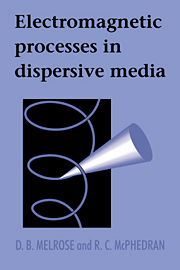Book contents
- Frontmatter
- Contents
- Preface
- List of Symbols
- Part One Electromagnetic Fields in Vacuo
- Part Two Electromagnetic Responses of Media
- Part Three Wave Properties
- Chapter 11 Wave Dispersion and Polarization
- Chapter 12 Waves in Anisotropic Crystals
- Chapter 13 Waves in Plasmas
- Chapter 14 The Polarization of Transverse Waves
- Chapter 15 Energetics and Damping of Waves
- Part Four Theory of Emission Processes
- Part Five Specific Emission Processes
- Bibliographic Notes
- Index
Chapter 15 - Energetics and Damping of Waves
Published online by Cambridge University Press: 27 October 2009
- Frontmatter
- Contents
- Preface
- List of Symbols
- Part One Electromagnetic Fields in Vacuo
- Part Two Electromagnetic Responses of Media
- Part Three Wave Properties
- Chapter 11 Wave Dispersion and Polarization
- Chapter 12 Waves in Anisotropic Crystals
- Chapter 13 Waves in Plasmas
- Chapter 14 The Polarization of Transverse Waves
- Chapter 15 Energetics and Damping of Waves
- Part Four Theory of Emission Processes
- Part Five Specific Emission Processes
- Bibliographic Notes
- Index
Summary
Preamble
Once the amplitude of a wave is defined, the electric and magnetic energies in the waves are calculated in terms of this amplitude. However, the total energy in the waves cannot be identified in any simple way in general. The damping of waves is used to identify the total energy by relating the damping to the dissipative part of the response tensor in two ways. One way involves calculating the work done by the dissipative process and equating this to the energy lost by the waves. The other way involves including damping in terms of an imaginary part of the frequency (§11.4). The equivalence of the two ways of treating damping provides an explicit expression for the total energy in the waves. A semiclassical description of a distribution of waves is useful for both formal and practical purposes; the semiclassical description is based on regarding the waves as a collection of wave quanta.
The Electric and Magnetic Energies in Waves
In any physical theory, energy is defined in terms of its mechanical equivalent. In §15.2 this is achieved by calculating the work done by an arbitrary dissipative process and equating it to the energy lost by the waves. An important preliminary step is to define the amplitude of the waves and to calculate the electric energy in waves in Fourier space by using the fact that the electric energy density in coordinate space is given by ½ε0∣E∣2. The magnetic energy in waves is calculated in an analogous way.
- Type
- Chapter
- Information
- Electromagnetic Processes in Dispersive Media , pp. 196 - 212Publisher: Cambridge University PressPrint publication year: 1991



